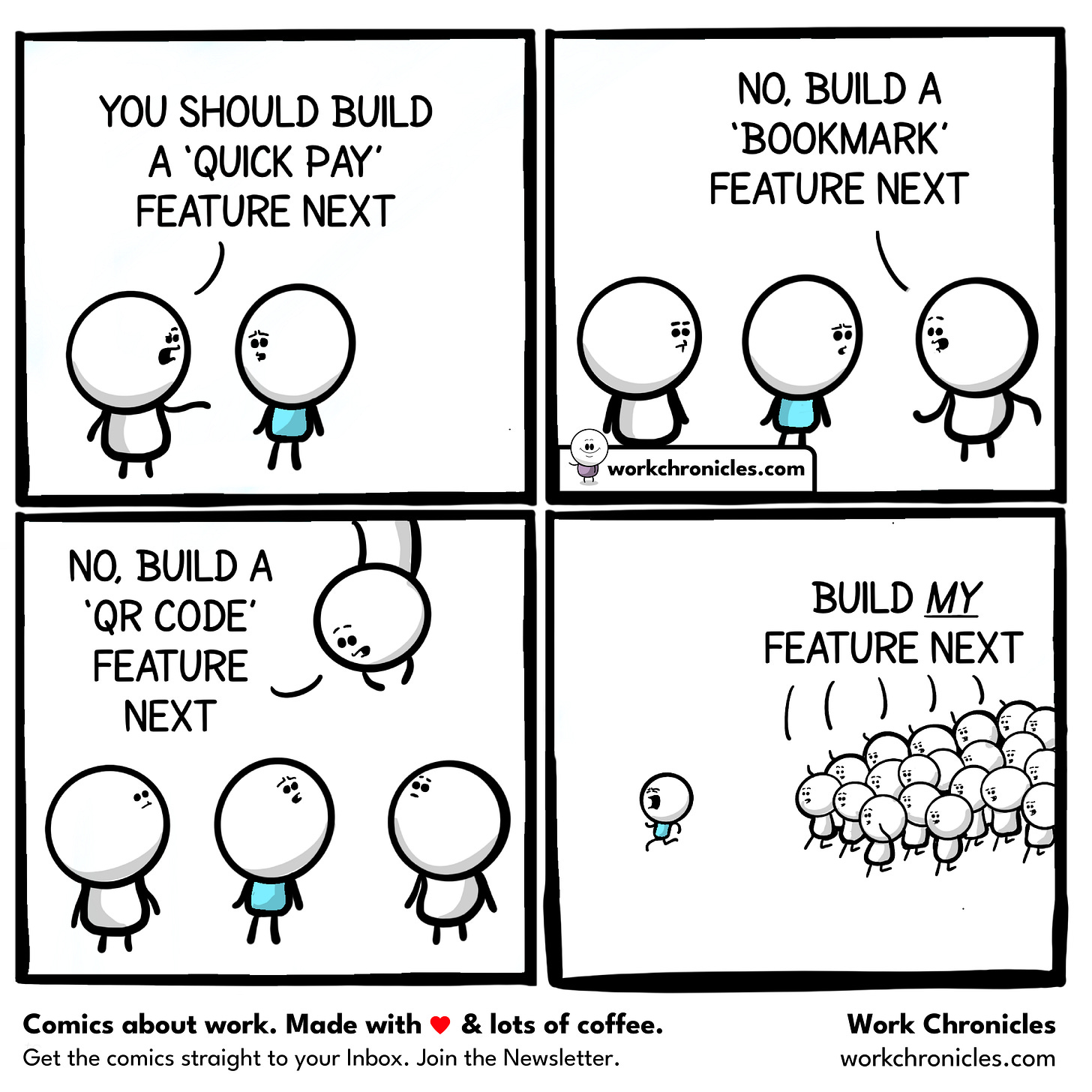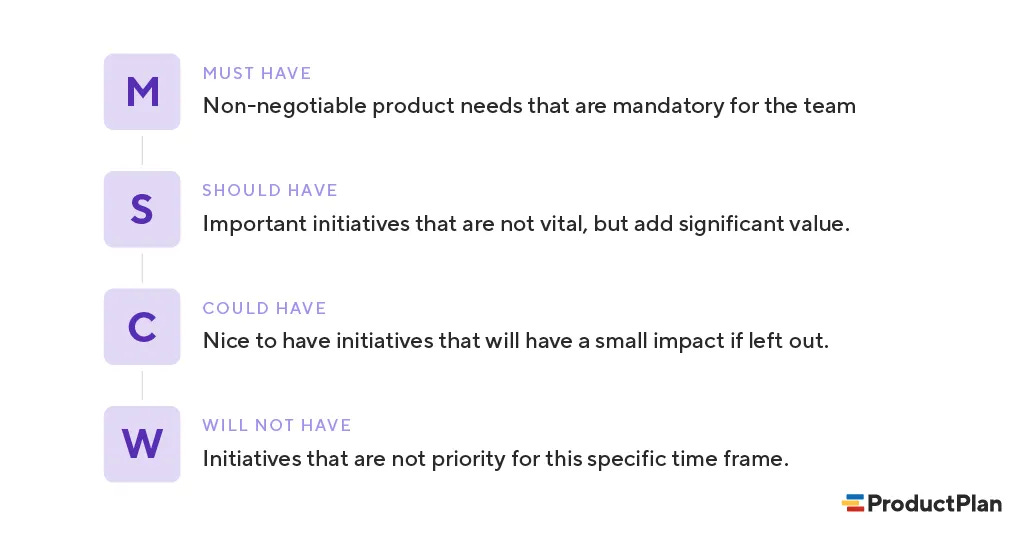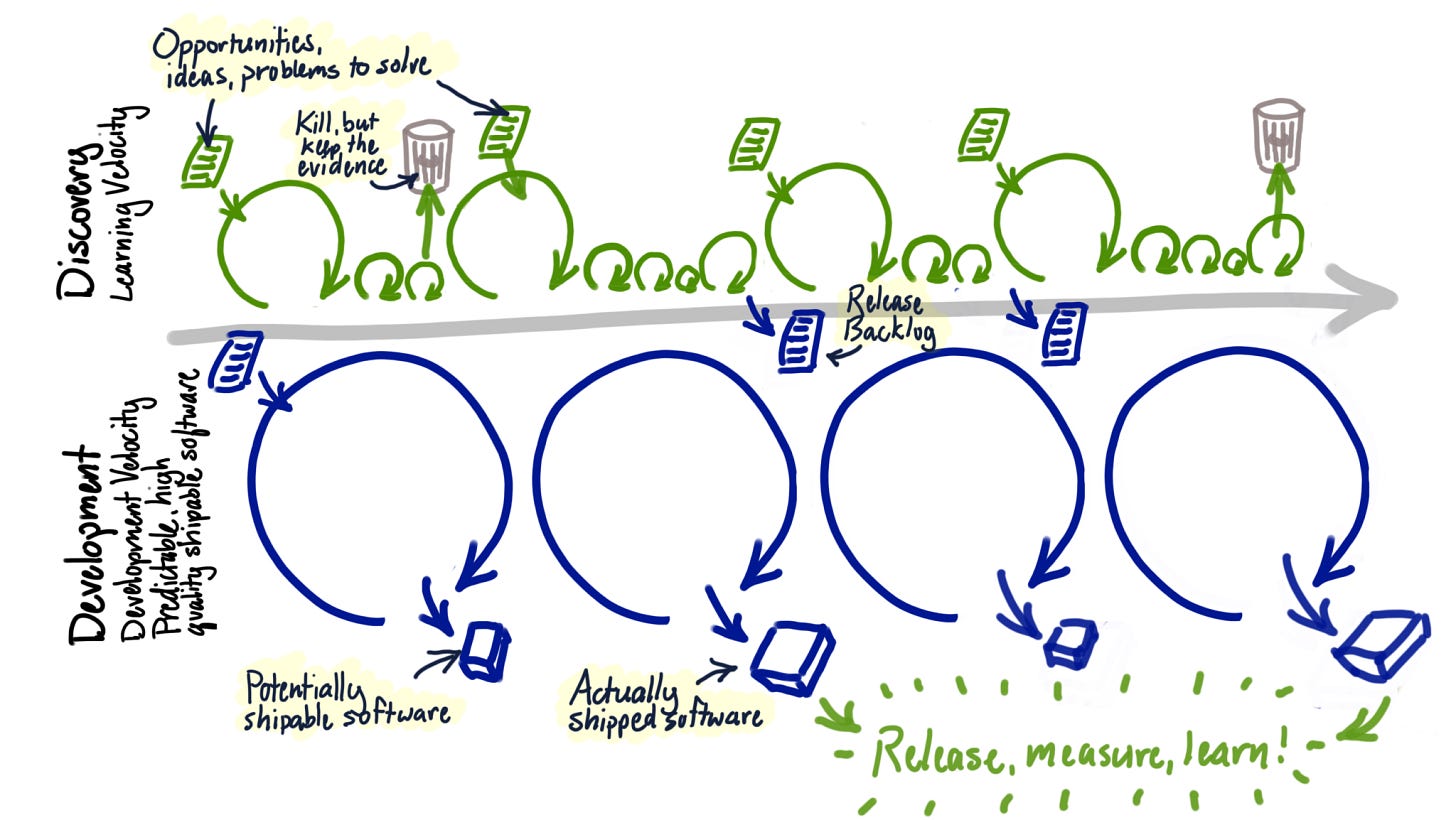The Art and Science of Prioritising Features: A PM's Playbook
Why Mastering Prioritisation is Essential for Product Managers
Product managers frequently find themselves at the center of a complex balancing act. PMs balance team strengths, corporate goals, and consumer demands while navigating a constantly shifting market. Prioritization is one of the most important abilities PMs need to have in order to be successful in this profession. This ability guarantees that we are working on the appropriate initiatives and hypothesis at the appropriate times and is the cornerstone of efficient product management. We will explore the importance of prioritization, the issues it helps with, popular frameworks for prioritization, the drawbacks of these models, and how dual-track agile might reduce risks. Lastly, we will talk about how important it is to match company strategy with priority lists, especially when there is a lack of data maturity.
The situation many PMs find themselves at:
Why Strong Product Managers Need to Master the Art of Prioritisation
Prioritisation is not just a skill; it’s an art form that distinguishes great product managers from the rest. Here’s why it’s so vital:
Maximising Impact: With limited resources and time, product managers must ensure that their teams are focused on initiatives that deliver the most value. Prioritisation helps in making informed decisions about where to allocate their team’s time and resources for maximum impact. This is especially increasingly important with the increased pressure on impact and ROI in a tech down turn.
Aligning with Strategic Goals: Effective prioritisation ensures that the product roadmap aligns with the company's strategic objectives. This alignment is crucial for driving the business forward and achieving long-term success.
Responding to Market Changes: The ability to pivot and reprioritise quickly in response to market shifts is critical. Strong prioritisation skills enable product managers to adapt their plans based on new data, competitor actions, and evolving customer needs.
Balancing Stakeholder Demands: Product managers often face conflicting requests from various stakeholders. Prioritisation helps in managing these demands, setting clear expectations, and ensuring that the most critical initiatives are tackled first.
Improving Team Morale and Productivity: When priorities are clear, teams can work more efficiently and with greater focus. This clarity reduces confusion, increases motivation, and ultimately enhances productivity.
Realistic and Tangible Issues Addressed by Prioritisation
Effective prioritisation helps product managers tackle several common challenges:
Competing and Sometimes, Conflicting Business Priorities
In any organisation, different departments and stakeholders have their own objectives and priorities. Sales might push for features that appeal to new customers, while customer support advocates for improvements that will reduce service tickets. Prioritisation helps balance these conflicting priorities by focusing on what will drive the most significant overall value for the business.
Requests from Multiple Stakeholders
Product managers are frequently bombarded with feature requests from a wide range of stakeholders, such as executives, sales teams, marketers, and customers. Prioritization frameworks aid in the objective evaluation of these demands, guaranteeing that data and strategic alignment—rather than the loudest voice in the room—are the basis for decisions.
Weak Data Maturity
In organisations with low data maturity, making informed decisions can be challenging. Prioritisation provides a structured approach to decision-making, allowing product managers to rely on a combination of available data, expert judgment, and strategic goals to guide their choices.
Limited Resources
Every product team faces constraints in terms of budget, time, and manpower. Prioritisation ensures that these limited resources are allocated to initiatives that offer the highest return on investment, enabling the team to do more with less.
Navigating Uncertainty
The product development process is inherently uncertain, with many variables that can impact success. Prioritisation frameworks help manage this uncertainty by providing a systematic approach to evaluating risks and potential rewards, allowing for more confident decision-making.
Common Prioritisation Frameworks
Several frameworks can help product managers prioritise effectively. Here are some of the most popular ones:
RICE (Reach, Impact, Confidence, Effort)
The RICE framework is a quantitative approach to prioritisation that evaluates features based on four criteria:
Reach: How many people will this initiative reach?
Impact: How much will this initiative impact the target audience?
Confidence: How confident are we in the estimates for reach and impact?
Effort: How much effort is required to implement this initiative?
By assigning scores to each criterion and calculating a total score, product managers can objectively compare different initiatives and prioritise those with the highest scores.
MoSCoW (Must have, Should have, Could have, Won't have)
The MoSCoW method categorises features into four groups:
Must have: Essential features that are critical for the product's success.
Should have: Important features that add significant value but are not critical.
Could have: Nice-to-have features that can be included if time and resources allow.
Won't have: Features that are not a priority for the current development cycle.
This framework helps product managers and stakeholders set clear expectations and focus on the most critical features first.
Kano Model
The Kano model categorises features based on customer satisfaction:
Basic needs: Features that customers expect and take for granted. Their absence causes dissatisfaction.
Performance needs: Features that increase customer satisfaction linearly with their level of performance.
Excitement needs: Features that delight customers and differentiate the product from competitors.
By understanding which category each feature falls into, product managers can prioritise those that will have the most significant impact on customer satisfaction.
Pitfalls of Prioritisation Models
While these models provide valuable frameworks for prioritisation, they are not without their pitfalls:
Data Quality
Prioritisation frameworks rely heavily on the quality of the data and insights used to inform them. If the input data is inaccurate or incomplete, the resulting prioritisation will be flawed. This "garbage in, garbage out" principle underscores the importance of using reliable data and continuously refining it.
Overemphasis on Quantitative Metrics
Quantitative prioritisation frameworks like RICE can sometimes overemphasise metrics at the expense of qualitative insights. It's essential to balance data-driven decision-making with an understanding of customer needs, market trends, and strategic goals.
Lack of Flexibility
Rigid adherence to a prioritisation framework can hinder adaptability. Product managers must be willing to adjust priorities based on new information, changing market conditions, and evolving business needs.
Stakeholder Alignment
Even the best prioritisation frameworks can fail if stakeholders are not aligned. Effective communication and stakeholder management are crucial to ensure that everyone understands and supports the prioritisation decisions.
Dual-Track Agile: Mitigating Prioritisation Risks
Dual-track agile is an approach that separates the product development process into two parallel tracks: discovery and delivery. This approach helps mitigate the risks associated with prioritisation by ensuring that both tracks are given adequate attention.
What is Dual-Track Agile?
In dual-track agile, the discovery track focuses on exploring and validating ideas before they are developed, while the delivery track focuses on building and shipping validated features. The key components of each track are:
Discovery Track
Customer Research: Understanding customer needs and pain points through interviews, surveys, and other research methods.
Idea Validation: Testing and validating ideas through prototypes, experiments, and user feedback.
Prioritisation: Continuously prioritising validated ideas based on their potential impact and feasibility.
Delivery Track
Development: Building and implementing validated features with a focus on quality and efficiency.
Testing: Ensuring that features work as intended through rigorous testing and quality assurance.
Release: Shipping features to customers and monitoring their performance.
Benefits of Dual-Track Agile
Dual-track agile offers several benefits that help mitigate the risks of prioritisation:
Balanced Resource Allocation
By allocating resources to both discovery and delivery, dual-track agile ensures that the team is not solely focused on building features without understanding customer needs. This balance prevents wasted effort on features that may not deliver value.
Continuous Learning and Adaptation
The discovery track allows for continuous learning and adaptation based on customer feedback and market changes. This iterative process ensures that the team is always working on the most relevant and impactful features.
Improved Prioritisation
With ongoing validation and feedback from the discovery track, prioritisation becomes more informed and accurate. Product managers can make better decisions based on real-world insights and validated data.
Enhanced Stakeholder Alignment
Dual-track agile promotes frequent communication and collaboration with stakeholders. This alignment ensures that everyone is on the same page and supports the prioritisation decisions.
The Importance of Company Strategy in Guiding Prioritisation
In any organisation, a well-defined company strategy is crucial for guiding prioritisation decisions. This strategy provides a clear direction and helps resolve competing hypotheses, especially in situations with low data maturity.
Aligning Prioritisation with Company Strategy
A strong company strategy serves as a North Star, guiding product managers in their prioritisation efforts. Here’s how it helps:
Strategic Objectives
The company’s strategic objectives outline the long-term goals and priorities. By aligning feature prioritisation with these objectives, product managers ensure that their efforts contribute to the broader vision of the organisation.
Value Proposition
Understanding the company’s value proposition helps product managers prioritise features that enhance this proposition. This alignment ensures that the product continues to deliver unique value to customers and maintains a competitive edge.
Market Positioning
The company’s market positioning influences prioritisation by highlighting areas where the product can differentiate itself. Prioritising features that strengthen the product’s market position helps drive growth and customer loyalty.
Competing Hypotheses and Low Data Maturity
In situations with low data maturity, prioritisation becomes more challenging due to the lack of reliable data. However, a strong company strategy can help guide decisions:
Strategic Prioritisation
In the absence of robust data, product managers can lean on the company’s long-term goals to provide clear direction. Strategic prioritisation means choosing initiatives that align with these goals, ensuring that efforts are not only immediate but also forward-thinking. This approach helps maintain focus on what matters most to the company's future success.
Balancing Short-Term Gains and Long-Term Vision
A company strategy helps balance short-term gains with long-term vision. Product managers can ensure that while they meet immediate business needs, they do not lose sight of the strategic initiatives that will drive long-term growth and innovation. This balance is especially important in environments with low data maturity, where it’s easy to get caught up in chasing short-term metrics.
Stakeholder Alignment
Effective stakeholder alignment is crucial when prioritising features with long-term potential or in low data maturity contexts. By involving key stakeholders in the prioritisation process and aligning decisions with the company strategy, product managers can build consensus and support for their choices. This alignment ensures that everyone understands and buys into the long-term vision, even if the immediate data is inconclusive.
Building Consensus
Involving stakeholders early and often in the prioritisation process helps build consensus and ensures that all perspectives are considered. This collaborative approach strengthens the commitment to the company's strategic vision and helps navigate the uncertainties inherent in low data maturity situations.
Communicating the Vision
Clear communication of the company strategy and how it informs prioritisation decisions is essential. Product managers should articulate how prioritised features align with the long-term goals and why they are critical despite the current lack of data. This transparency fosters trust and aligns everyone towards common objectives.
Mastering the art of prioritisation is essential for product managers aiming to deliver maximum value to their customers and organisations. By understanding and addressing common challenges, leveraging effective prioritisation frameworks, and adopting approaches like dual-track agile, product managers can navigate the complexities of their role with greater confidence and success. Additionally, aligning prioritisation with the company strategy ensures that decisions are made with a clear vision and purpose, even in situations with low data maturity.
As product managers, our ability to prioritise effectively not only drives the success of our products but also fosters a culture of continuous learning, adaptation, and collaboration. By honing this skill, we can lead our teams to achieve remarkable outcomes and make a lasting impact on our organisations.






